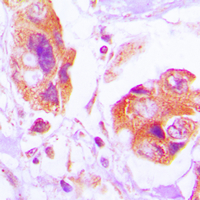Filamin A antibody [C2], C-term
GTX112939
ApplicationsImmunoFluorescence, Western Blot, ImmunoCytoChemistry, ImmunoHistoChemistry, ImmunoHistoChemistry Paraffin
Product group Antibodies
TargetFLNA
Overview
- SupplierGeneTex
- Product NameFilamin A antibody [C2], C-term
- Delivery Days Customer9
- Application Supplier NoteWB: 1:500-1:3000. ICC/IF: 1:100-1:1000. IHC-P: 1:100-1:1000. *Optimal dilutions/concentrations should be determined by the researcher.Not tested in other applications.
- ApplicationsImmunoFluorescence, Western Blot, ImmunoCytoChemistry, ImmunoHistoChemistry, ImmunoHistoChemistry Paraffin
- CertificationResearch Use Only
- ClonalityPolyclonal
- Concentration0.42 mg/ml
- ConjugateUnconjugated
- Gene ID2316
- Target nameFLNA
- Target descriptionfilamin A
- Target synonymsABP-280, ABPX, CSBS, CVD1, FGS2, FLN, FLN-A, FLN1, FMD, MNS, NHBP, OPD, OPD1, OPD2, XLVD, XMVD, filamin-A, actin binding protein 280, alpha-filamin, endothelial actin-binding protein, epididymis secretory sperm binding protein, filamin A, alpha, filamin-1, non-muscle filamin
- HostRabbit
- IsotypeIgG
- Protein IDP21333
- Protein NameFilamin-A
- Scientific DescriptionThe protein encoded by this gene is an actin-binding protein that crosslinks actin filaments and links actin filaments to membrane glycoproteins. The encoded protein is involved in remodeling the cytoskeleton to effect changes in cell shape and migration. This protein interacts with integrins, transmembrane receptor complexes, and second messengers. Defects in this gene are a cause of several syndromes, including periventricular nodular heterotopias (PVNH1, PVNH4), otopalatodigital syndromes (OPD1, OPD2), frontometaphyseal dysplasia (FMD), Melnick-Needles syndrome (MNS), and X-linked congenital idiopathic intestinal pseudoobstruction (CIIPX). Two transcript variants encoding different isoforms have been found for this gene.
- Storage Instruction-20°C or -80°C,2°C to 8°C
- UNSPSC12352203
References
- Salim C, Muders H, Jäger A, et al. Role of chaperone-assisted selective autophagy (CASA) in mechanical stress protection of periodontal ligament cells. J Orofac Orthop. 2022,83(1):1-12. doi: 10.1007/s00056-021-00358-3Read this paper
- Yang HH, Zhai WJ, Kuo HC. The putative involvement of actin-binding proteins and cytoskeleton proteins in pathological mechanisms of ketamine cystitis-Revealed by a prospective pilot study using proteomic approaches. Proteomics Clin Appl. 2017,11(3-4). doi: 10.1002/prca.201600085Read this paper





